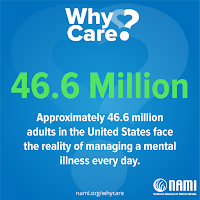May was Mental Health Awareness Month. While there is much to be gained from a focused effort towards increasing awareness during the span of a month, the timing of this blogpost is intentionally after May as mental health is a year-round priority. Since May 1949, organizations across the United States promoting mental well-being such as Mental Health America and the National Alliance on Mental Illness (NAMI) have observed May as the month to advocate for mental health. In the early years, advocacy efforts revolved around promoting awareness about depression, anxiety, bipolar disorder and schizophrenia. Today, while awareness efforts continue to address specific mental disorders, there is a greater focus on stigma and its role in preventing people with mental illness from seeking help. In addition, advocacy efforts today focus on promoting the notion that mental health conditions should be treated long before they reach critical points in the disease process through preventive efforts, early identification, intervention and integrated care efforts.
The Mental Health Bell
 |
| Picture of the Mental Health Bell, courtesy MHA website |
There is no greater symbol for mental health advocacy than
the Mental Health Bell. For the 46.6 million Americans facing the reality of
mental illness, the poignant symbol of the bell is a reminder that while the
journey ahead is long, mental health advocacy is making progress.
The story of the Bell is a story of hope: In 1953, the
300-pound bell was cast from metal shackles and restraints that were used on
persons with mental illnesses, collected from hundreds of mental hospitals and
mental asylums across America. The inscription on the bell reads:
“Cast from the shackles which
bound them, this bell shall ring out for the mentally ill and victory over
mental illness.”
The
Mental Health Bell is displayed at the National Mental Health Association's
Headquarters in Alexandria, VA.
Mental Health Advocacy
People with mental illness today no longer deal with the
physical indignities of iron shackles, but they are still battling figurative
restraints. The issue is not about segregation in asylums, but about dispensing
fair and compassionate treatment to people with mental illness. The primary use
of the medical (disease) model to define and treat mental illness has been
challenged with research showing that the use of social supports including
housing, employment and emotional assistance produces better quality of life
outcomes at lower costs.
The issues of self-determination, state guardianship and
involuntary treatment remain key topics of disagreement. In addition, the
responsibility of government to pay for services is offset by budget cuts in
behavioral health services. The Bureau of Justice
Statistics found that in 2017 over 2 million people were incarcerated in US prisons
and jails. Mental illness among prisoners is pervasive. The MHA reports that “currently
more people receive their first mental health services.…through the criminal
justice system than through the public community mental health system.” Chicago’s
Cook County Jail has been called "America’s largest mental health facility." Community-based remediation programs for people with mental illness are needed to reduce incarceration, and the harms of treating mental illness through the prison system.
There
is growing recognition for the need to integrate behavioral health within the
continuum of general health. There is a need for mental health professionals to
spread awareness and engage in advocacy efforts at local, state, and national
levels. To stay informed on advocacy issues regarding systems
transformation, services, privacy, criminal justice and other mental health
topics, read MHA’s Position
Statements on the various issues.
Mental Health Awareness Resource Guide
- The National Alliance on Mental Health (NAMI) has chosen "CureStigma" as the focus of their awareness campaign this year. Have you taken the “Have you been infected by stigma?” quiz?
- NAMI’s WhyCare? Campaign focuses on raising awareness through information sharing and resources for dealing with mental illness. They provide awareness resources (graphics, emojis, stickers and social media messages) that can be downloaded and shared, like the ones below.
- Advocacy efforts by Mental Health America (MHA) focus on the "B4Stage4 Philosophy" which promotes early identification and intervention with mental illness, just as we do with other progressive diseases.
- Mental Health America’s downloadable 2019 4Mind4Body Outreach Toolkit is a resource that caters to the needs of people dealing with chronic mental health issues. Click here to access the toolkits of previous years that provide resources ranging from fact sheets to information about the gut-brain connection to the social determinants of health and much more.
- MHA’s #MentalIllnessFeelsLike harnesses the power of sharing the stories about real people’s struggles with mental illness.
- Mental health screening events and suicide prevention programs are organized by MindWise Innovations. Facilitate a screening in your community or workplace.
Impacting Mental Health Awareness in Your Community
If you consider yourself an advocate for mental health but you
are unsure about how to contribute, here are some ways you can make an
immediate impact:
- Talk about mental health. Ask questions. Don’t judge.
- When you ask someone how they're doing, listen to the answer. Ask follow-up questions, and encourage sharing.
- Use non-judgmental language. Don't use terms like "crazy" and "insane" as general insults. They perpetuate the stigma of mental illness.
- Read about mental illness. Educate yourself, and dispel your own myths (see resources above).
- Talk to your children about mental health. There is a growing epidemic of depression and anxiety in youth today.
- Have you had personal encounters with mental illness? Share your story. Your story may be what encourages someone to seek help.




